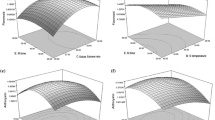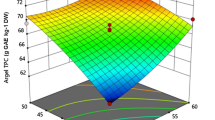Abstract
Black soybeans have been reported to contain high antioxidant content, including anthocyanins. Ultrasound-assisted water extraction of antioxidants from Korean black soybeans (Glycine max [L.] Merr. Cheongja4ho) was investigated for the first time. A three-level, three-factor Box-Behnken design using a response surface methodology (RSM) was employed to optimize the conditions for the maximum yields of three dependent variables, including total anthocyanin content, total phenol content, and 2,2′-azino-bis (3-ethylbenzothiazoline-6-sulfonic acid) (ABTS) radical scavenging activity, based on 17 different experiments. The solid-liquid ratio (X1, 1/30–1/50 g mL−1), extraction time (X2, 1–9 min), and amplitude (X3, 20–100%) significantly affected three dependent variables. The optimized conditions were solid-liquid ratio of 49.1 g mL−1, extraction time of 8.59 min, and amplitude of 81.4%. At the optimum point, the total anthocyanin content, total phenol content, and ABTS•+ scavenging activity were 66.44, 940.96, and 242.45 mg 100 g−1. The difference (%) between the predicted and experimental values was less than 6.40%, indicating that the model fits well. The conditions optimized for ultrasound-assisted water extraction of antioxidants from black soybeans can be applied as an efficient technique for extracting anthocyanins in plants on a larger scale.



Similar content being viewed by others
References
Al-Dhabi NA, Ponmurugan K, Jeganathan PM (2017) Development and validation of ultrasound-assisted solid-liquid extraction of phenolic compounds from waste spent coffee grounds. Ultrason Sonochem 34:206–213
Bezerra MA, Santelli RE, Oliveira EP, Villar LS, Escaleira LA (2008) Response surface methodology (RSM) as a tool for optimization in analytical chemistry. Talanta 76:965–977
Cacace JE, Mazza G (2003) Mass transfer process during extraction of phenolic compounds from milled berries. J Food Eng 59:379–389
Camel V (2000) Microwave-assisted solvent extraction of environmental samples. Trends Anal Chem 19(4):229–248
Castañeda-Ovando A, Pacheco-Hernández ML, Páez-Hernández ME, Rodríguez JA, Galán-Vidal CA (2009) Chemical studies of anthocyanins: a review. Food Chem 113(4):859–871
Celli GB, Ghanem A, Brooks MS (2015) Optimization of ultrasound-assisted extraction of anthocyanins from haskap berries (Lonicera caerulea L.) using response surface methodology. Ultrason Sonochem 27:449–455
Choung MG, Baek IY, Kang ST, Han WY, Shin DC, Moon HP, Kang KH (2001) Isolation and determination of anthocyanins in seed coats of black soybean (Glycine max (L.) Merr.). J Agric Food Chem 49(12):5848–5851
Das AB, Goud VV, Das C (2017) Extraction of phenolic compounds and anthocyanin from black and purple rice bran (Oryza sativa L.) using ultrasound: a comparative analysis and phytochemical profiling. Ind Crop Prod 95:332–341
Demirdöven A, Özdoğan K, Erdoğan-tokatli K (2015) Extraction of anthocyanins from red cabbage by ultrasonic and conventional methods: optimization and evaluation. J Food Biochem 39:491–500
Dranca F, Oroian M (2016) Optimization of ultrasound-assisted extraction of total monomeric anthocyanin (TMA) and total phenolic content (TPC) from eggplant (Solanum melongena L.) peel. Ultrason Sonochem 31:637–646
Ghafoor K, Choi YH, Jeon JY, Jo IH (2009) Optimization of ultrasound-assisted extraction of phenolic compounds, antioxidants, and anthocyanins from grape (Vitis vinifera) seeds. J Agric Food Chem 57:4988–4944
Ghafoor K, Hui T, Choi YH (2011) Optimization of ultrasonic-assisted extraction of total anthocyanins from grape peel by using response surface methodology. J Food Biochem 35:735–746
He B, Zhang LL, Yue XY, Liang J, Jiang J, Gao XL, Yue PX (2016) Optimization of ultrasound-assisted extraction of phenolic compounds and anthocyanins from blueberry (Vaccinium ashei) wine pomace. Food Chem 204(1):70–76
Jiang HL, Yang JL, Shi YP (2017) Optimization of ultrasonic cell grinder extraction of anthocyanins from blueberry using response surface methodology. Ultrason Sonochem 34:325–331
Koh K, Youn JE, Kim HS (2014) Identification of anthocyanins in black soybean (Glycine max (L.) Merr.) varieties. J Food Sci Technol 51(2):377–381
Lai J, Xin C, Zhao Y, Feng B, He C, Dong Y, Fang Y, Wei S (2013) Optimization of ultrasonic assisted extraction of antioxidants from black soybean (Glycine max var) sprouts using response surface methodology. Molecules 18:1101–1110
Lee J, Durst RW, Wrolstad RE (2005) Determination of total monomeric anthocyanin pigment content of fruit juices, beverages, natural colorants, and wines by the pH differential method: collaborative study. J AOAC Int 88(5):1269–1278
Lien CY, Chan CF, Lai YC, Huang CL, Liao WC (2012) Ultrasound-assisted anthocyanin extraction of purple sweet potato variety TNG73, Ipomoea batatas, L. Sep Sci Technol 47(8):1241–1247
Mané C, Souquet JM, Ollé D, Verriés C, Véran F, Mazerolles G, Cheynier V, Fulcrand H (2007) Optimization of simultaneous flavanol, phenolic acid, and anthocyanin extraction from grapes using an experimental design: application to the characterization of champagne grape varieties. J Agric Food Chem 55:7224–7233
Mane S, Bremner DH, Tziboula-Clarke A, Lemos MA (2015) Effect of ultrasound on the extraction of total anthocyanins from purple majesty potato. Ultrason Sonochem 27:509–514
Mojica L, Berhow M, de Mejia EG (2017) Black bean anthocyanin-rich extracts as food colorants: physicochemical stability and antidiabetes potential. Food Chem 229(15):628–639
Muangrat R, Pongsirikul I, Blanco PH (2017) Ultrasound assisted extraction of anthocyanins and total phenolic compounds from dried cob of purple waxy corn using response surface methodology. J Food Process Preserv 42(2):1–11
Odabaş HI, Koca I (2016) Application of response surface methodology for optimizing the recovery of phenolic compounds from hazelnut skin using different extraction methods. Ind Crop Prod 91(30):114–124
Pandey A, Belwal T, Sekar C, Bhatt ID, Rawal RS (2018) Optimization of ultrasonic-assisted extraction (UAE) of phenolics and antioxidant compounds from rhizomes of Rheum moorcroftianum using response surface methodology (RSM). Ind Crop Prod 119:218–225
Picó Y (2013) Ultrasound-assisted extraction for food and environmental samples. Trends Anal Chem 43:84–99
Rastogi NK (2011) Opportunities and challenges in application of ultrasound in food processing. Crit Rev Food Sci Nutr 51(8):705–722
Rocha JCG, Procopio FR, Mendonça AC, Vieira LM, Perrone IT, Barros AR, Stringheta PC (2018) Optimization of ultrasound-assisted extraction of phenolic compounds from jussara (Euterpe edulis M.) and blueberry (Vaccinium myrtillus) fruits. Food Sci Technol 38(1):45–53
Ryu D, Koh E (2018) Application of response surface methodology to acidified water extraction of black soybeans for improving anthocyanin content, total phenols content and antioxidant activity. Food Chem 261(30):260–266
Sancho RAS, Pavan VP, Pastore GM (2015) Effect of in vitro digestion on bioactive compounds and antioxidant activity of common bean seed coats. Food Res Int 76(1):74–78
Shi J, Gong J, Liu J, Wu X, Zhang Y (2009) Antioxidant capacity of extract from edible flowers of Prunus mume in China and its active components. LWT-Food Sci Technol 42(2):47–482
Singleton VL, Rossi JA (1965) Colorimetry of total phenolics with phosphomolybdic-phosphotungstic acid reagents. Am J Enol Vitic 16:144–158
Soria AC, Villamiel M (2010) Effect of ultrasound on the technological properties and bioactivity of food: a review. Trends Food Sci Technol 21(7):323–331
Sun T, Ho CT (2005) Antioxidant activities of buckwheat extracts. Food Chem 90:743–749
Takeoka GR, Dao LT, Full GH, Wong RY, Harden LA, Edwards RH, Berrois JDJ (1997) Characterization of black bean (Phaseolus vulgaris L.) anthocyanins. J Agric Food Chem 45(9):3395–3400
Tiwari BK, O’Donnell CP, Patras A, Cullen PJ (2008) Anthocyanin and ascorbic acid degradation in sonicated strawberry juice. J Agric Food Chem 56(21):10071–10077
Vilkhu K, Mawson R, Simons L, Bates D (2008) Application and opportunities for ultrasound assisted extraction in the food industry – a review. Innov Food Sci Emerg Technol 9(2):161–169
Xu B, Chang SKCC (2008) Antioxidant capacity of seed coat, dehulled bean and whole black soybeans in relation to their distributions of total phenols, phenols acids, anthocyanins and isoflavones. J Agric Food Chem 56(18):8365–8373
Yang L, Yin P, Fan H, Xue Q, Li K, Li X, Sun L, Liu Y (2017) Response surface methodology optimization of ultrasonic-assisted extraction of Acer Truncatum leaves for maximal phenolic yield and antioxidant activity. Molecules 22(2):1–21
Zeng L, Xia Z (2002) The improvement and influence of ultrasonic and microwave irradiation on the extraction of traditional Chinese medicine. Chem Res Appl 14:245–249
Zhang RF, Zhang FX, Zhang MW, Wei ZC, Yang CY, Zhang Y, Tang XJ, Deng YY, Chi JW (2011) Phenolic composition and antioxidant activity in seed coats of 60 Chinese black soybean (Glycine max L. Merr.) varieties. J Agric Food Chem 59(11):5935–5944
Zhao CL, Yu YQ, Chen ZJ, Wen GS, Wei FG, Zheng Q, Wang CD, Xiao XL (2017) Stability-increasing effects of anthocyanin glycosyl acylation. Food Chem 214:119–128
Funding
This research was supported by the Basic Science Research Program through the National Research Foundation of Korea (NRF), funded by the Ministry of Education (2017R1D1A1B03028841).
Author information
Authors and Affiliations
Corresponding author
Ethics declarations
Conflict of Interest
Dayeon Ryu declares that she has no conflict of interest. Eunmi Koh declares that she has no conflict of interest.
Ethical Approval
This article does not contain any studies involving human participants or animals performed by any of the authors.
Informed Consent
Not applicable.
Additional information
Publisher’s Note
Springer Nature remains neutral with regard to jurisdictional claims in published maps and institutional affiliations.
Rights and permissions
About this article
Cite this article
Ryu, D., Koh, E. Optimization of Ultrasound-Assisted Extraction of Anthocyanins and Phenolic Compounds from Black Soybeans (Glycine max L.). Food Anal. Methods 12, 1382–1389 (2019). https://doi.org/10.1007/s12161-019-01462-2
Received:
Accepted:
Published:
Issue Date:
DOI: https://doi.org/10.1007/s12161-019-01462-2




